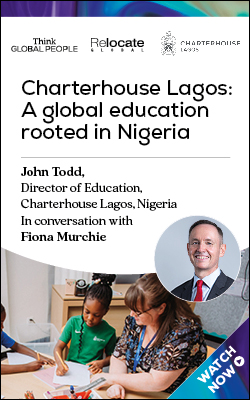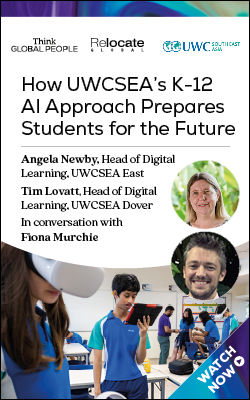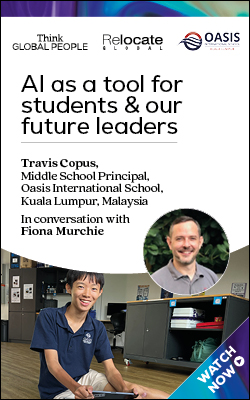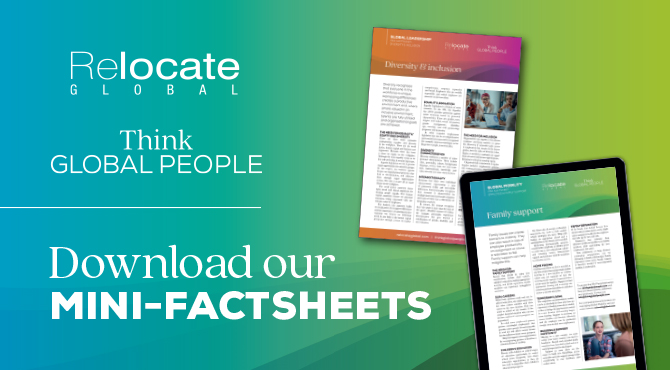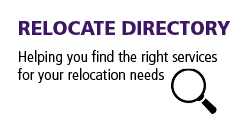The evolving role of global mobility: from back office to strategic business partner
The global mobility industry is facing a “perfect storm” of an increasing workload and new levels of complexity, global uncertainty and risk. Its role has moved beyond managing a defined pool of assignees and towards a responsibility across the whole of the organisation to handle remote work, assist with setting up hybrid working on a short- or long-term basis, and dealing with more informal requests from staff to “work from anywhere”.

https://relocate-edit.redsnapper.net/mortar/oedit.obyx?node=18477&tab=32


“Everyone in the company is now a “customer,” not just a defined group of international assignees,” explains John Rason, group head of consulting at Santa Fe Relocation. John, who has many years of experience in the industry, has seen the global mobility function change dramatically.“Previously, organisations may have had some people working remotely, but the pandemic acted as an accelerant,” he says. “Mobility used to have a formalised cadre of people whereas now for international or global businesses, businesses, the whole company has become their customer. If a company is taking a flexible approach to remote working requests, and tries to grant most requests, you might end up with a team of five people in mobility who used to look after 300 international workers, and suddenly an extra 1,000 people want to work 15 days in Turkey or Cuba or Venezuela. That is a completely different scenario, especially since such remote working has not been planned and often needs a lot of due diligence.”Recognised as a thought leader and speaker on strategic international HR, talent management and Global Mobility, and author of Santa Fe Relocation’s award winning annual Global Mobility Survey, has been an FCIPD for 20 years and holds an MA in Managing Human Resources. He has more than 30 years combined international HR and Big Four consultancy experience, and he now works with global organisations to create value and improve the structure of their Global Mobility programmes, focusing on aligning strategic objectives with operational delivery.
Trends and challenges in global mobility
Global mobility is no longer just about moving employees from A to B, John says. The function has become a central player in navigating an increasingly volatile, uncertain, complex, and ambiguous world. Budget constraints, geopolitical instability, evolving employee expectations, and the widespread rise of remote and hybrid work have significantly expanded both the scope and pressure on global mobility teams.“You've got this perfect storm of complexity,” John says. “The world has become more uncertain, due to socio and geopolitical events. Global mobility professionals have seen a huge increase in workload, without necessarily an increase in resources, and they are often feeling burnt out.”Mobility works in three key areas – firstly making the move happen operationally and dealing with the logistics of moving, setting up visas and sorting out immigration. Secondly, mobility teams need to deal with compliance, risk and analytics, which is a different skill set. If your organisation uses manual systems, and you are in multiple countries and you are working with multiple suppliers, then it is a huge task and time consuming to keep track of everything. This is especially the case if the business and suppliers are all asking for data.“Finally, you have the strategic advisory role around talent management, talent planning and strategy,” he says. “In larger organisations, mobility needs to have the ear of the C-suite and be involved in discussing the implications of deploying people to a country or situations where there is a personal and/or tax and compliance risk.”This is where good relationships with suppliers, which can evolve into partnerships, is so important.“When things become more complex, the relationship you have with your supply chain, whether it is your tax partner, immigration, or relocation specialist, should be one that is closer, proactive and more specialised,” he says.Tighter budgets and higher expectations
Unfortunately, cost pressures mean fewer resources and a greater workload. In larger organisations, technology can take the strain and contribute efficiencies, but while big business might have the budget to implement new systems, smaller companies are less likely to do so.In some organisations there is a dedicated global mobility function, while in others it is handled by Human Resources (HR) or other departments. These departments also face time pressures in the form of greater due diligence for unplanned or informal requests to work abroad. While the employee might see this as a simple request – for example, being able to work from a different location for a short period of time – for the global mobility or HR department this may raise significant legal and financial issues around compliance, employer’s duty of care, immigration legislation and tax risks to the company. Even one person working in a different jurisdiction can leave an organisation vulnerable to being taxable in that country if the remote work duties trigger a permanent establishment risk..“Think about the relationship you have with your business,” John says. “How engaged are you with your leadership? It is important that global mobility professionals can influence and advise leadership, so that when they are making decisions, they are not making decisions in isolation. For example, they can let the managers know that due to changes in immigration now, maybe in some countries it is going to take significantly longer than say, three weeks, which would make a significant difference to the efficiency and viability of a project.”There are also technology tools for business travel, which can help global mobility teams assess when a business traveller or an employee will need a visa or when they might be about to trigger a taxable situation.Geopolitical and regulatory instability
John says that changes in government administrations following elections last year, trade policy shifts and global conflicts are creating unpredictable operating conditions. In order to ensure that the employee or assignee and the organisation are not put at risk, global mobility teams are having to track changes to immigration law, tax exposures, and the implication of creating entities in new countries, where the business decides to shift supply-chain to mitigate tariff or other logistical challenges.Overlaying the rise of remote work are global changes that make every decision harder. New government administrations and shifting trade agreements affect budgets and how easy it is to invest and move talent. There are ongoing conflicts in Eastern Europe, the Middle East, and tensions in the Far East. The compliance risks associated with casual or unplanned mobility have increased, and yet many mobility teams are still using spreadsheets to manage their programs.In addition to remote work has expectations, employees increasingly want more choice and ‘career self-ownership’ and flexibility is expected and normalised. In many cases, it is a critical component of a package to attract and retain top talent. Many organisations are struggling to accommodate requests from staff in a work-from-anywhere world.The rise in cybersecurity threats is another key concern. The growing reliance on digital systems creates vulnerabilities—especially for older generations less comfortable with tech. As systems become more complex, traditional problem-solving skills are no longer sufficient and outages can now bring entire systems to a halt.Read related articles
- Global Leaders Forum: Forging a path in our fragile world
- 20th Anniversary Award for Outstanding Contribution to Research and Thought Leadership
- Best research contribution or book
- Charting the road to 2030: what does the future hold for global mobility?
Watch video highlights of Global Leaders Forum
What are the strategic shifts in global mobility?
John identifies three pillars of the global mobility function:Operational execution – this covers visas, relocation and logistics, tax briefings.Compliance and analytics – duty of care, tax issues and mitigating legal risks, data analytics.Strategic advisory – workforce planning, engaging with the C-suite, advising on trends and future strategy and commercial opportunities e.g. being involved in tenders and project planning.He says global mobility professionals are often overwhelmed, reporting that they spend too much time with suppliers, and paradoxically, wanting more C-suite engagement but not given the opportunity to do so. He suggests a solution might be to shift from transactional to strategic business partnerships with tax, immigration, and relocation providers. There is also perhaps, an opportunity to consolidate and manage suppliers more effectively to reduce complexity and enhance accountability.While demands on global mobility have grown dramatically, in many organisations the function still operates with legacy systems, relatively small teams, and limited visibility at the strategic level. He suggests that in order to manage these pressures, organisations could:Reframe global mobility’s role internally – rather than just executing requests, global mobility professionals must become trusted advisors, influencing business decisions before they are finalised, and becoming involved at the policy and strategy stage.Early involvement in planning: ensuring that global mobility teams are involved in contributing knowledge and expertise at the tender and bidding process, so that projects can be properly budgeted for.Understand the requirements of the individuals you are assigning – this might require your organisation to realign policies to reflect modern family situations and values, for example treating the need for an assignee to care for an older family member with the same respect and consideration as is currently given to accommodating children and schooling needs with the relocating family.Rethinking partnerships: This about what you can keep in-house, versus what needs to be outsourced. John calls this the “make/buy/borrow model”. Rather than expending time and energy with lots of different vendors, find a few strong partners you can work with and see the process as collaborative and build long-lasting relationships.Be proactive, not reactive: Different companies need different strategies, and you will need to find a solution that is suitable for your business needs, budget, and culture. This might include using tools, data and technology to filter and manage the demand efficiently. It also means educate leaders, managers and the C-suite on the real risks, costs and opportunities involved in mobility-related decisions.Leadership, presence and Artificial Intelligence (AI)
John emphasises that leadership “presence” is key. Executives need to be physically present to understand markets and make better-informed decisions. While some tasks can be done virtually, remote leadership has limitations, especially in fast-changing environments.He says that organisations should view AI and automation as enablers, rather than not replacements, and as tools that can increase efficiency and help with decision making but which are ultimately overseen by a human. Although AI is growing quickly, there are still many companies where it has not been adopted, for example, 56 per cent of organisations still use Excel spreadsheets. The successful organisation of the future will be agile and digital, but still managed and monitored by humans, not instead of them.“AI forms part of a new array of tools, but how you use that AI, how you use automation, will be very different, depending on the size and scope of your business,” he says. “Massive multinationals or transnationals or global companies will have the budget and the experience to know they need to spend. But if you're a smaller business, you may not have the budget to do so.”AI is changing everything—from modelling assignment costs to automating compliance tracking.“The biggest fear for business leaders now is getting their AI strategy wrong,” John says. It is not about replacing the human—it is about giving humans better tools and releasing them from work that can be automated, in a risk free way. Used correctly, it can help filter thousands of requests down to manageable volumes, but it must be handled ethically, and with a clear understanding of its limits."We need to be agile, human, and digital—with humans managing the digital, not the other way around.”He warns that there is a real potential risk of de-skilling mobility professionals, if core competencies are outsourced training and education are key, and global mobility the right skills to have a stronger voice at the top, not necessarily a permanent seat at the boardroom table, but regular engagement with leadership—particularly during planning and decision-making phases.“When mobility is involved too late, cost, risk, and compliance issues arise,” John says, citing the example of an engineering consultancy where project directors would bid for global contracts before asking mobility how much the people side would really cost. The result was that costs ended up being doubled after they had won the bid. By embedding global mobility into commercial planning at the tendering stage, you can save time, money, and credibility.The human layer: new expectations, new realities
As John mentioned previously, employee expectations have also changed. Global assignments now come with more personal expectations. John cites an example of a senior executive wants to go on assignment but needs to bring a dependent elderly parent with Alzheimer’s. That would not be in the traditional policy, but the stakes—both human and financial—are significant. Should companies invest in expensive schooling and housing for relocating families, yet deny reasonable caregiving support? These decisions go beyond logistics—they touch culture, empathy, and employer brand, as well as the ability to retain top talent. Global mobility must be seen as an investment not a cost decision.Global mobility trends and sector dynamics
Global mobility is currently being shaped by several macro trends. One key area is the movement of high-net-worth individuals—particularly Americans relocating to Europe, Ireland, and the UK. This has increased since the start of the year, driven in part by changes in US policy.On the corporate side, demand is varied. The defence sector is expanding rapidly due to geopolitical instability, requiring significant talent mobility.However, compared to two decades ago, business conditions are far less predictable. Factors such as automation, AI, and socio-economic pressures have made future planning more complex. Looking ahead, sectors like space exploration, hydrogen energy, and entertainment (e.g., new film studio developments) are emerging as mobility drivers. Space, in particular, could become a major focus by 2030, with countries vying for influence beyond Earth. Although international agreements currently prevent sovereignty claims on the Moon, interest in space-based resources is rising.Technological advancements from space exploration have historically benefited society—much like innovations stemming from the 1969 Moon landing. Similar trickle-down effects are anticipated in areas like ultra-fast global travel and remote sensing. These trends may lead to new mobility patterns, involving engineers, pharmaceutical professionals, and defence personnel.To get there, businesses must reframe mobility’s purpose, resource it properly, and invite it into decision-making. Global mobility, when enabled and empowered, could be the key to staying connected, compliant, and competitive, if organisations are willing to rethink the structure and purpose of their mobility functions.How to be agile in a changing world
- Organisations can explore how global mobility teams can prioritise tasks, adjust their structure and resources and redefine their function in order to stay agile under the mounting pressures discussed.
- Managers can consider how AI and automation could be integrated into global mobility processes to increase efficiency and reduce complexity.
- Reinforce the need for mobility professionals to focus on educating and influencing leadership to make informed decisions related to international assignments.



Find out more about the Think Global People and Think Women community and events.

Subscribe to Relocate Extra, our monthly newsletter, to get all the latest international assignments and global mobility news.Relocate’s new Global Mobility Toolkit provides free information, practical advice and support for HR, global mobility managers and global teams operating overseas.
©2025 Re:locate magazine, published by Profile Locations, Spray Hill, Hastings Road, Lamberhurst, Kent TN3 8JB. All rights reserved. This publication (or any part thereof) may not be reproduced in any form without the prior written permission of Profile Locations. Profile Locations accepts no liability for the accuracy of the contents or any opinions expressed herein.












